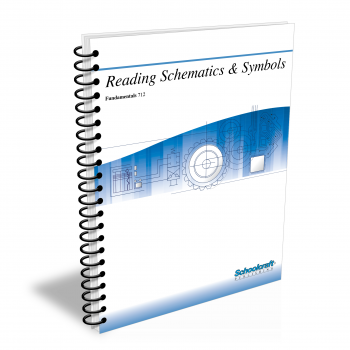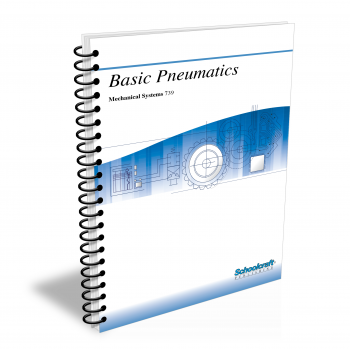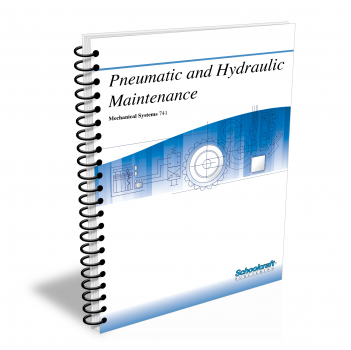Pneumatic Troubleshooting

Course Number: 740
The Pneumatic Troubleshooting textbook is the second of a pair on pneumatics, following the 739 textbook on Basic Pneumatics. After an overview and a chapter on using pneumatic diagrams to understand a system, the textbook describes the installation of components and the maintenance of the system. The chapters that follow describe troubleshooting for all the major components of a typical pneumatic system. The final chapter deals with systems that use a combination of pneumatics and hydraulics.
Does your curriculum require additional topics not included in this textbook? Build a customized version of the Pneumatic Troubleshooting textbook below.
This textbook has been recently updated
to include topics lists, objectives, & key terms for every chapter.
Recommended Contact Hours – 15
Preview a Chapter
Available Supporting Material
- Table of Contents
- Exam Copies
- Suggested Titles
Table of Contents
Chapter 1: Pneumatic Systems
Topics: Air supply system; Reciprocating and rotary compressors; Cooling; Compressor maintenance; Air-line filters and lubrication
Learning Objectives:
- Explain the operation of linear actuators-cylinders-in a typical pneumatic circuit.
- Describe the various types of compressors and how they work.
- Define intercooling and aftercooling.
- Describe basic preventive maintenance procedures for compressors.
- List the components of an effective delivered-air system and explain how they work together.
- Describe the three main types of air-line lubrication.
Chapter 2: Pneumatic Diagrams
Topics: Schematic symbol construction; Diagramming an air supply; Simple pneumatic systems; Timing and safety circuits; System schematics
Learning Objectives:
- Explain the different types of symbols used in pneumatic schematic diagrams-how they are constructed and what they show.
- Describe the operation of timing and safety circuits.
- Analyze the schematic diagram of a fluid-power system.
Chapter 3: Installing Pneumatic Components
Topics: Compressor intakes and foundations; Aftercoolers; Receivers; Dryers; Pipe installation and support; Tubing and hose fittings; System installation
Learning Objectives:
- Describe the proper installation of the compressor and its auxiliaries.
- Describe the installation of aftercoolers, receivers, and dryers.
- Explain the correct procedures for installing pipes, tubes, and hoses in pneumatic systems.
- Describe the installation of control valves, solenoid coils, and cylinders.
Chapter 4: System Maintenance
Topics: Control system maintenance; Cylinder maintenance; Tool maintenance; Logs and records; Automatic recorders and recording charts
Learning Objectives:
- Explain the concept of planned maintenance.
- Describe the basic procedures for maintaining the compressor and other important components in a pneumatic system.
- Describe the maintenance of industrial control circuit components.
- Explain the proper maintenance of pneumatic tools.
- Discuss the various types of maintenance logs and explain what kind of information is recorded in each.
Chapter 5: System Troubleshooting
Topics: Locating troubles; Operations manual; Checking the air supply; Troubleshooting valves and actuators; Interlocks; Final adjustments
Learning Objectives:
- List, in proper sequence, the steps to be taken in troubleshooting a pneumatic system.
- Name and describe the five important parts of every pneumatic system's operations manual.
- Describe procedures for troubleshooting the actuator.
- Explain how to check control valves, sequence valves, and interlocks.
Chapter 6: Compressor Troubleshooting
Topics: Compressor cooling, lubrication, and valves; Crankcase ventilation; Piston rings; Bearings; Control systems; Troubleshooting
Learning Objectives:
- Describe methods of cooling and lubricating reciprocating compressors.
- Explain the proper maintenance of compressor valves.
- Identify problems associated with the control system of a compressor.
- Describe the basic maintenance requirements of rotary, vane, rotary-screw, and centrifugal compressors.
Chapter 7: Valve Troubleshooting
Topics: Checking manual overrides, circuit sequence, and solenoids; Improper sequence and valve shifting; Control timing; Lubrication problems
Learning Objectives:
- Outline how to isolate a control malfunction in a pneumatic circuit.
- Explain how to troubleshoot a nonstarting or nonoperating circuit, improper sequencing of the circuit, and miscellaneous problems related to the equipment.
- Describe the proper procedures for checking electric solenoids.
- Explain how to check for problems related to valve shifting, control timing, and lubrication.
Chapter 8: Cylinder Troubleshooting
Topics: Cylinder construction; Checking for correct size, clogged filters, frozen air lines, and cylinder misalignment; Worn packings and seals; Controls
Learning Objectives:
- Define the different types of pneumatic cylinders.
- Describe the construction of a typical cylinder.
- Describe the proper procedures for troubleshooting cylinders, including checking for misalignment, worn packings, and adequate air pressure.
- Explain general installation techniques for cylinders and accessories.
Chapter 9: Motor Troubleshooting
Topics: Checking for sufficient air; Contamination; Lubrication; Air motor abuse; Hose and clamp maintenance; Vane and piston motors
Learning Objectives:
- Explain how to check for sufficient clean air when troubleshooting an inoperative air motor.
- Explain how to keep hoses, clamps, and couplings in good condition.
- Describe the operation and maintenance of vane, radial piston, and axial-piston air motors.
Chapter 10: Pneumatic/Hydraulic Systems
Topics: Air-oil tanks; Pressure boosters; Hydraulic control; Pneumatic cushioning; System interlock; Pneumatic servos; Troubleshooting
Learning Objectives:
- Explain why and how compressed air and hydraulic pressure are combined.
- Describe the role of boosters in pneumatic/hydraulic systems.
- Explain how single-pressure and dual-pressure booster systems work.
- Describe the advantages and disadvantages of combined air-oil cylinders.
- Explain how pneumatic and hydraulic actions can be interlocked.
- Discuss the proper troubleshooting procedures for air-oil systems.
Request Exam Copies
Exam Copies
Ready to see a copy of our textbooks? After selecting which textbooks you’d like to review for your course, you can submit your request by either logging in or creating an account so we know where to ship your exam copies. A representative from Schoolcraft will contact you to confirm and finish processing your request.
Exam copies are always free and yours to keep.
Selected Exam Copies
none selected
* Maximum of five copies can be ordered


